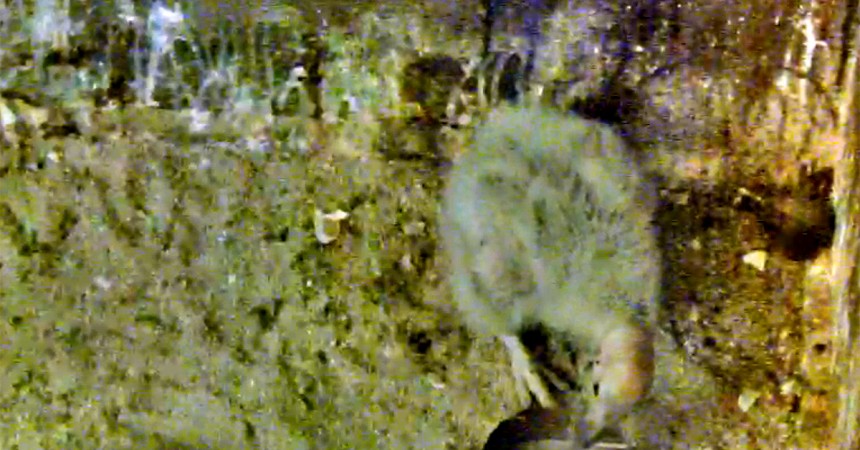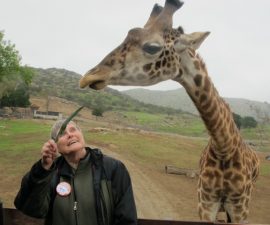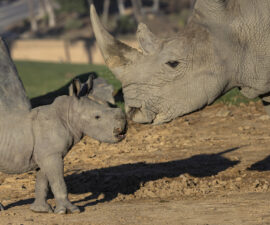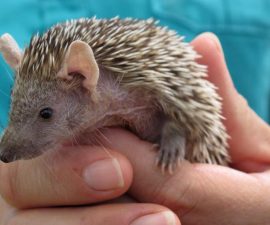It’s hard to believe Ackaw is already three weeks old! Our Condor Cam chick hatched April 1, 2016, weighing around 6 ounces (165 grams). You may have noticed that during the first couple weeks after hatch, the parents brooded (sat on) the chick almost constantly, providing protection and warmth. And, of course, they feed the youngster.
The parents eat food that we offer in the flight pen, bringing it to the chick in their crop. They regurgitate the food for the chick, providing a warm and nutritious meal. Mmmmmmm! The diet we provide varies, depending on the day, but it can include rabbits, rats, trout, beef spleen, and ground meat. While the chick is very young, it is often difficult to witness a feeding, since the parents are standing directly above the chick, blocking the camera’s view. If you see the parents slightly bobbing their heads while standing over the chick, feeding is occurring.
Both the male and female California condor provides care for the chick. This drive is very strong and it’s not uncommon to see the parents vying for time with the chick, especially immediately after hatching. This happens in the form of leaning into each other, pushing their way onto the chick; scooping the chick away from the other parent; or nipping at neck skin and tugging at feathers to get the other bird to move.
Sometimes viewers are concerned about the number of times that the chick gets stepped on by its parents. In many species, ranging from hummingbirds to elephants, babies get slightly squished by the parents. Usually, it’s just a minor misstep and the baby will let the parent know with a brief vocalization. Condors are no different or more fragile. They are very hearty little chicks!
As young as four days of age, we have seen chicks sifting through the sand in the nest, picking up items on their own. We’ve even seen chicks swallowing small pieces of its eggshell for dietary calcium.
At approximately two to three weeks of age, the real fun of condor chick-viewing begins! The chick is getting bigger, weighing between 1 to 2.5 pounds (50 to 1,200 grams), and often pokes its head out from under the parents’ wings. The adults might spend less time sitting on the chick and leave it unattended for longer periods of time. Never fear, they’re nearby—often just out of the camera’s view.
At this stage, so you may catch a glimpse of food actually being transferred from the parent to the chick. The chick’s crop may be visible when it’s full; look for a bald patch of skin between the size of a golf ball and a tennis ball. You will also witness a very common behavior called “wing-begging.” This is when the chick is begging for food, flapping one or both of its stubby little wings and bobbing its head excitedly. This behavior can persist until after the chick fledges, or leaves the nest, at four to five months.
The chick hatched wearing a fluffy coat of white down feathers. The main function of down is insulation; it can either keep a bird cool or warm, whatever its body needs. By two to three weeks of age, the chick’s white down is starting to transition to gray. This can make the chick look dirty, but the youngster and its parents frequently groom the feathers, so rest assured that they are working the way they should be. The new darker feathers help the chick blend in with the substrate and the nest cave walls, since the parents are not covering the chick as much as before.
Some viewers have noticed what look like scabs on the chick’s head and neck or wounds on its body, matting its down feathers. What you’re seeing is regurgitated food stuck to the face or body. Feeding can be quite exciting for the chick and some of the food doesn’t make it into the mouth! The chick obviously can’t take a bath at this age, but the food dries up, gets crusty, and flakes off. Anyone that has seen the big condors eat on exhibit at Condor Ridge at the Safari Park or Elephant Odyssey at the San Diego Zoo can attest to the condors’ ability to keep clean after a messy meal.
By the way, the presence of flies in the nest is nothing to worry about. Keep in mind that condors are carnivores, feed their chicks via regurgitation, and nest in cavities that are often sheltered from the wind. All of these components add up to a very comfortable environment for flies as well as condors. Fortunately, condors have an excellent immune system and are only mildly annoyed by the flies!
At about three weeks of age, the condor chick starts to thermoregulate, or control its body temperature, and the parents start leaving the chick on its own during the day. Depending on the ambient temperature, the chick may be seen shivering or panting in an effort to warm or cool itself. On warm days, you might see the chick inflate air sacs in its chin and neck to cool down; this can also occur after a particularly filling meal. Often, the parents may spend time in the nest with the chick without sitting on it.
The three-week-old chick is more mobile, scooting around the nest on its haunches, or tarsal joints. (We call it the “tarsal crawl.”) It can’t quite stand on its feet, but it can follow its parents and investigate different parts of the nest. You may see the chick start to gather items (feather, scraps of old food) from around the nest and move them to one corner. These feathers and old food scraps are often brought to the nest by the parents. The chick likes to sit or sleep on this pile and play with the different items. We don’t know if the parents are bringing these items to the nest specifically for the chick or if it’s just coincidence, but the chick loves to investigate and play with them!
As the parents start leaving the chick alone for longer periods of time, it will be easier to watch the chick as it sleeps; and just like all growing youngsters, condor chicks sleep A LOT. With longer legs and gawky bodies, they often will be sprawled out, wings askew, in odd positions when they sleep.
Happy viewing and thanks so much for your support!





